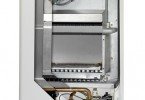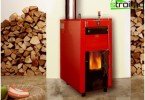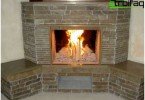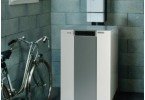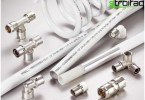Heat pumps for heating
It’s been the 21st century outside, and some villagers still heat their houses in the old fashioned way – with wood and coal. True, some have already become happy owners of gas stoves, but civilization cannot reach everyone, and gas workers are in no hurry. But what about those whose homes are far from all goods? Are they really going to have to burn old stoves with wood for several more years? Fortunately, alternative options have long appeared on the market – heat pumps for heating, which allow you to warm up or cool the room to the desired temperature without any difficulty on the part of the person, and even heat the water.
Content
- What is a heat pump??
- Principle of work – energy transfer
- Types of Heat Pumps
- Geothermal heat pump
- Air heat pump
- Heat recovery pumps
- Heat pumps air to air
- Thermal systems water water
- Air water pumps
What is a heat pump??
A heat pump is a special device that takes energy from its environment and converts it into heat or cold, depending on what a person requires of it at a given time. Using this equipment, you can not only heat homes in the cold season, but also cool them in the summer. The heat obtained in this way can also be used to heat water, which will be used for the hot water supply system..
This technical device can also significantly save money, since the heat received during the operation of the pump costs more than three quarters for free, because it is extracted from the environment, which so far belongs to all of humanity, and not to some private entrepreneur.
Heat pumps reviews that can be found in large quantities on the network – this is an excellent solution for heating residential premises, because they are economical and environmentally friendly.
Principle of work – energy transfer
The principle of operation of such a device is approximately the same as that of a conventional refrigerator, available in every kitchen. It is based on the transfer of energy, in this case heat, from a cold body to a warm one. For these purposes, the pumps use refrigerant, which when exposed to heat, begins to evaporate in a chamber with low temperature and pressure. As these parameters (pressure and temperature) increase in the compressor, the refrigerant gradually gives off heat, condensing in a chamber with a high temperature and the same high pressure. Thus, practically from nothing, heat is obtained.
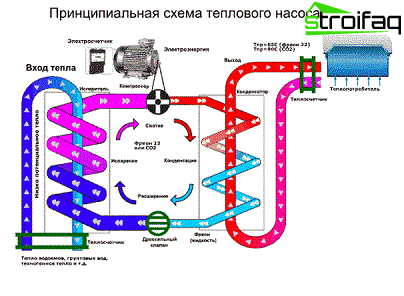
The principle of operation of the heat pump
Types of Heat Pumps
Depending on the source, which gives off its heat, pumps are divided into the following types:
- geothermal
- aerial
- using secondary heat.
Geothermal heat pump
A geothermal heat pump uses the heat of the earth, groundwater or groundwater to heat the cooling.
In turn, this equipment can be divided into two types:
- closed type pumps,
- open type pumps
The first can be horizontal, vertical or water. Horizontal geothermal heat pumps of a closed type have a collector that is placed sinuous or in rings in specially dug horizontal trenches below the depth of freezing of the soil (from 1.2 meters or more). This method of installing heating equipment is the most cost-effective for private homes, however, the main criterion for choosing such a installation is the availability of sufficient space for its placement.
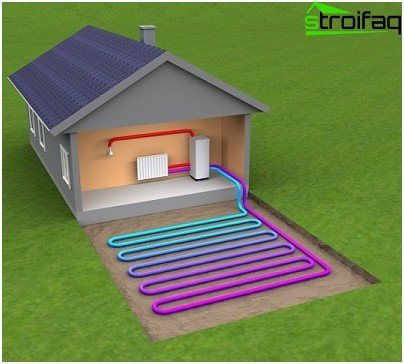
Horizontal placement of the heat pump is applicable in areas with sufficient space for the installation of the system
Vertical closed-type pumps are equipped with a collector, which is placed vertically in shallow wells (up to 2 meters). This option for the placement of thermal equipment is used when the size of the land is not too large or the owner does not want to disturb the landscape of his garden.
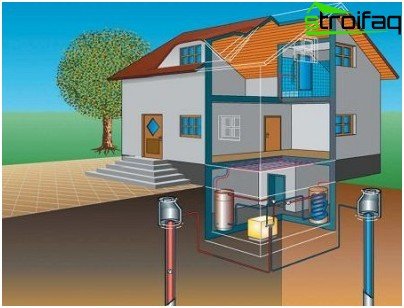
Scheme of a geothermal vertical pump, this type of placement is suitable for installation in areas with a limited area
Water pumps have the same collector, but placed either in rings or in a tortuous manner in any reservoir below the depth of its freezing. This is the cheapest option of all, but there are some nuances here, concerning, first of all, the depth and volume of the reservoir itself, and for each region these requirements are different.
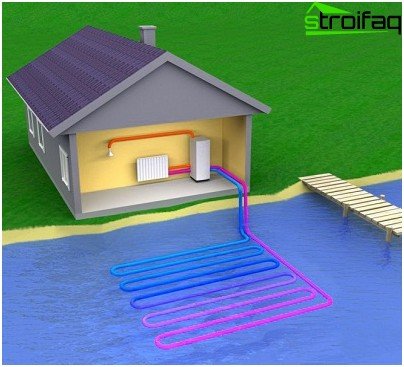
Installation of a water geothermal pump is possible with sufficient depth and area of the reservoir
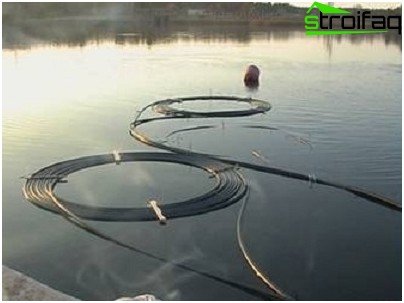
Installation of a geothermal pump in a pond requires permission to install
Geothermal pumps of the open type, as a rule, use water, which circulates through the system itself in the “open mode”, that is, after the entire cycle, the water returns back to the ground. This method of heating a house can be used only when there is a sufficiently large amount of clean water on the site and there is permission for installation.
Air heat pump
An air heat pump uses ambient air as a heat source. Roughly speaking, this is a conventional air conditioner, although not quite ordinary, because the purpose of this equipment is to completely replace the old radiator batteries, which means that their power should be several times higher than the power of a standard split system. The disadvantage of this pump is a sharp decrease in the coefficient of conversion of air to heat when the air temperature drops below -15 degrees.
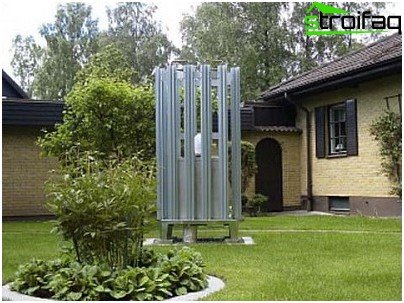
The air heat pump takes up little space, fits into the countryside
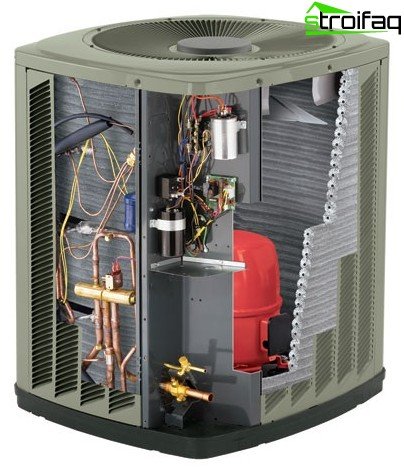
Sectional air heat pump
Heat recovery pumps
This type of heat pump uses any type of secondary heat as a source of heat extraction, for example, the heat of a central heating pipeline. Most often, this method of heating is used by large industrial enterprises where there are similar sources of stray heat..
Depending on the type of coolant, heat pumps are divided into the following categories:
- heat pump air air
- heat pump water water
- heat pump air water
- heat pump earth water
Heat pumps air to air
This type of pump is equipped with an evaporator and compressor, which are mounted outside the building. Atmospheric air entering the evaporator transfers its heat to the refrigerant, which in turn transfers it to the condenser. The capacitor itself is installed indoors, which the owner plans to heat. With the help of a fan, cold air is pumped through the pump condenser and returned back to the room already warmed up. It can be concluded that air-to-air heat pumps can be used to heat the house only with warm air, which means that in winter this heating option is not effective.
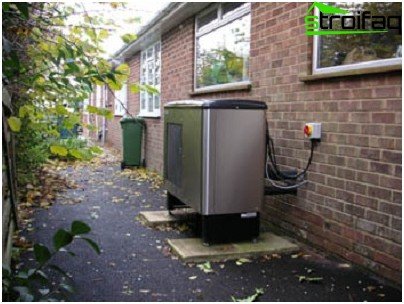
Air to air heat pump is applicable for equipping urban apartments and suburban buildings
Thermal systems water water
The heat source in this type of pumps can be surface (lakes, rivers, etc.) or soil water (wells), as well as waste water from process plants. The temperature of such sources even in winter does not drop below +5 degrees, which allows heating rooms of any size without problems.
If there is a river or a lake in the vicinity of the house, then the circuit is laid directly on the bottom of the reservoir, the main condition is that the water must be flowing, and the size of the reservoir is sufficient to allow the heat pump circuit to be placed at its bottom.
In the absence of reservoirs, the circuit can be laid directly underground, however, groundwater should be located at a depth acceptable for installation. Such a system is quite effective, because the temperature of groundwater even in winter ranges from +8 to +12 degrees, which guarantees optimal pump operation and comfortable living conditions for people.
Heat pumps water water – an excellent option for heating equipment for those who live in close proximity to water bodies, because installing this system is very simple.
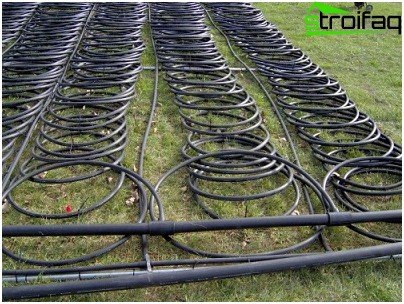
The heat pump water water can be laid on the bottom of the pond or placed in a water-saturated bed of soil
Air water pumps
The heat pump air-water extracts heat from the external air masses and transfers it to water. Modern units of this type are designed for year-round use with a winter temperature of at least -15 degrees, with a decrease in this indicator, the device will work, of course, however, the heat generated by it will not be enough to warm the room efficiently.
In fact, it is an air conditioner that is able not only to cool the rooms during the summer heat, but also to heat the house in autumn weather and winter frosts.
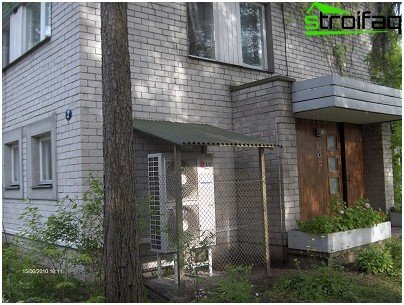
The heat pump air-water will help to create a comfortable temperature in any season
Advantages of installing heat pumps
- High economic efficiency. Given that 1 kW of energy spent on the operation of the installation accounts for from 2.5 to 5 and even more kW of converted heat energy, such units fully justify their high cost.
- Autonomy and versatility. You can use heat pumps in any region and in any climatic conditions, no communications should be connected to them, except for electricity, but even in its absence a small diesel generator with a power of 2-5 kW is enough to heat a country house with an area of up to 300 square meters . m.
- Environmental friendliness. During operation of the heat pump, no harmful or toxic substances are released.
- Durability. The device is designed very simply, this is what allows it to work without major repairs for more than 50 years.
- Operational safety. The absence of any fire and explosive materials, very often used for space heating, makes heat pumps absolutely safe. Not a single part of the device heats up to temperatures that can cause a fire.
- No permissions and documents required. Having bought the installation, you just need to mount it and use it for your pleasure. No red tape on cabinets, no approvals, no papers.
- Comfort. The device works stably, fluctuations in humidity and temperature in the house are minimal, noise is completely absent, and the ability to control the pump via the Internet turns the device into a real miracle technique.
- Prospects. Prices for all energy carriers are constantly growing, which makes their use as a heat source not entirely advisable. Saying the same thing about heat pumps just won’t turn your tongue, because the water in the lake or the air around the house costs nothing, which means that the heat of your house will always cost as much as you yourself evaluate it.
Most likely, those who value their money and their time are interested in this article, just do not rush into the purchase, because the price of thermal equipment of this type is very high. However, after weighing all the pros and cons, evaluating your capabilities, and deciding for yourself that you just need a heat pump. Believe me, you will not regret it!


